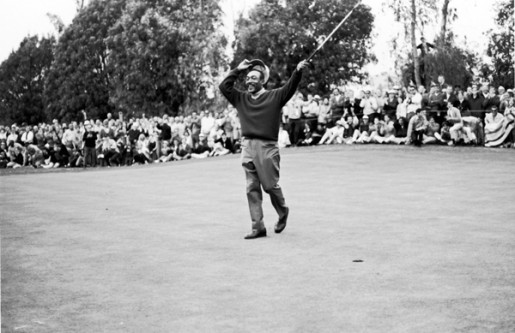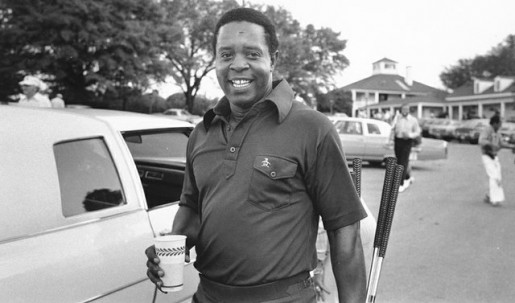Did Augusta National Golf Club Change Their Rules to Keep an African-American Player From Possibly Qualifying for the Masters in 1962?
This is the latest in a series of examinations of urban legends related to golf and whether they are true or false.
GOLF URBAN LEGEND: Augusta National Golf Club changed their rules to keep an African-American player from possibly qualifying for the Masters in 1962.
With the Augusta National Golf Club finally adding a female member to their club last year, I thought it would be interesting to examine another controversial period in Augusta history, the years before Lee Elder became the first African-American player to compete in the Masters Tournament in 1975. Charlie Sifford was a pioneer among African-Americans in the world of golf. There had been some African-American players in the late 19th Century, but the first half of the 20th Century had pretty much put an end to the inclusion of African-Americans in the sport.
Sifford, a former caddy, challenged the establishment beginning in the early 1950s and he suffered a great deal of abuse for his efforts as he became the first African-American member of the Professional Golfers’ Association of America (PGA of America). What was surely aggravating for Sifford was the fact that for all of his struggles for equality, he did not even end up becoming the first player to break the color barrier at the Masters, as Lee Elder (as noted above) received that honor.
Much has been written about the supposed efforts that Augusta went through to keep Sifford and other African-American players from competing in the Masters. The most famous example is one that Sifford has recalled from 1962. In Curt Sampson’s book, The Masters: Golf, Money, and Power in Augusta, Georgia, Sampson wrote: “Sifford shot 67 to lead the Canadian Open in ’62. Shortly thereafter, according to Charlie, someone from Augusta called the clubhouse at Royal Montreal Golf Club. A sign was immediately posted on a bulletin board: ‘The Masters golf tournament has announced that it will not offer an automatic invitation to the winner of this year’s Canadian Open,’ which it had in the past. The Royal Canadian Golf Association could not confirm Sifford’s charge.”
Is this true?
In general, there are two competing theories as to why the Masters Tournament got more selective in the 1950s and 1960s. Some critics charge that it was so that they could keep out minority players like Sifford. The Augusta National Golf Club would argue that the post-War boom in interest in the Masters got to the point where players who would normally turn down an invitation to the Masters suddenly were more than willing to accept said invitation. As a result, the enrollment at the tournament was going up and Clifford Roberts, chairman of Augusta wanted to maintain an air of the Masters being “the best of the best” so he kept the amount of players in the tournament artificially low. Thus, the amount of automatic invitations to the Masters shrunk from the 1940 high point of the top thirty finishers of the previous Masters and previous U.S. Open to twenty-four in 1947 and then sixteen in 1958. All the other categories of automatic invitation were similarly reduced (like if you won the U.S. Open you used to get a lifetime invitation but that changed in 1963 to just the last ten years and then it shrunk further as the years went by). This shrinking of the automatic invitations was seen by some as not just a way to keep the Masters “prestigious,” but also to keep minority golfers from qualifying (as some joked, whatever ranking Charlie Sifford reached, the cut-off point would be one spot higher than Sifford’s ranking. If he was 16th, it would be the top 15 being invited. If he was 15th, it would be the top 14, etc.).
The counter-argument to this, though, which was argued quite well in David Owen’s The Making of the Masters: Clifford Roberts, Augusta National, and Golf’s Most Prestigious Tournament, is that while they were shrinking the overall automatic invitation pool, they were increasing the amount of automatic bids for successful players on the PGA Tour. This increase would help minority candidates, not hurt them. And, of course, the final major change to the rules came in 1972 when the change was made that any winner of a PGA tour tournament would be invited (there were forty-six such tournaments in 1972). This was a major boon for less established golfers (which described most minority golfers at the time. Of course, they were only less established because they never got a chance to play earlier because of racism). It was no coincidence that this was how Lee Elder made it to the Masters in 1975 (he won the Monsanto Open in 1974).
Anyhow, to the specific story at hand, the winner of the Canadian Open did not get an automatic bid in the years before 1962 (in addition, the 1962 Canadian Open was held in Laval-sur-le-Lac not at the Royal Montreal Golf Club, but that’s a minor mistake). If Sifford saw the sign in question, it very well could have been (and this is obviously just speculation on my part) an instance of Augusta wishing to remind people that the winner of the Canadian Open didn’t get an automatic bid so that they wouldn’t have to tell Sifford (and the angry media) after he had won. The confusion likely came over the policy of the Augusta National Golf Club to give an invitation to any CANADIAN winner of the Canadian Open. Roberts and Augusta were very big on international golf play, so they made a point of trying to bring in foreign players for the Masters on an invitational basis. This is how Gary Player (one of the greatest golfers of all-time) was brought to the United States from South Africa to compete in the Masters in 1957. Roberts was willing to give out invitations for foreign players but he would not do the same for American-born minorities like Sifford or Elder. He argued that he felt that American players had a number of ways of earning their way into the tournament and it would be unfair to them to give them an invitation that they could earn on their own. I’ll leave you to your own judgment about whether you trust Roberts’ motivations there for giving treatment to foreign players that he did not afford Americans. But whatever the case, if an American won the Canadian Open (and an American won pretty much EVERY Canadian Open) they would not get an automatic bid. Only the four “major” tournaments earned you an automatic bid for the Masters back then, the Masters itself, the U.S Open, the PGA Championship and the British Open. The Canadian Open was treated like all the other PGA tour tournaments, which were not automatic bids until 1972, as noted earlier.
As I have noted in the past when addressing legends involving Clifford Roberts (like this one from awhile back about whether he said that “as long as I’m alive, golfers will be white, and caddies will be black”), I am not saying that Clifford Roberts did not have a poor attitude towards African-American golfers in the United States. Again, as noted earlier, he did give invitations to foreign players who did not “earn” their way into the Masters. Would it really be so bad to give the same treatment to minority golfers from the United States? Especially given the poor treatment African-American golfers had received for years, particularly in the Southern United States? Even when the United States House of Representatives specifically asked him to do so (which they did in 1973, to no avail)?
I think that all of those questions are extremely fair to ask. However, there is the notion that Roberts did not make it easy for African-Americans to get into the Masters and there is the notion that he specifically changed rules to keep African-Americans out. I can believe the former, but I do not think that the latter is correct. Heck, there was even a specific rule that allowed for past U.S. Open winners to vote for whoever they wanted to play in the Masters. The past winners never voted for an African-American golfer (similarly, the past Amateur champions were also given a ballot where they could choose any deserving amateur golfer – they, too, never voted for a minority amateur golfer). In 1969, when Sifford won the Los Angeles Open, he only received a single vote (take a bow, Art Small Jr., you rock!). And the eventual winner of the ballot that year, Bob Murphy, ended up qualifying for the Masters under a different method! In addition, as noted before, the rule change in 1972 to automatically invite any winner of a PGA tour tournament was practically designed to open the pool of possible golfers for the Masters. Does that sound like a guy who was trying to change rules to keep African-Americans out of the Masters? I don’t believe so. He did not hurry their inclusion into the Masters, but nor did he specifically come up with ways to bar them.
I am certainly not saying that Charlie Sifford does not have good reason to carry a grudge against Clifford Roberts and the golfing establishment of the 1950s and 1960s. He does have good reason. He went through much abuse just because of the color of his skin. And Roberts had many opportunities to reach out in the name of good will and offer an invitation to the Masters and he chose not to. I can see why Sifford would be angry.
But at the same time, I do not believe any specific rule was changed in 1962 to keep him out of the Masters tournament, so I feel that the legend is…
STATUS: False
Thanks to David Owen and Curt Sampson for their excellent books about the Masters. Owen’s defense of Roberts is quite good, although I think he and I differ a bit on how much racism impacted Roberts’ decision-making. Still, his book is an excellent read.
Feel free (heck, I implore you!) to write in with your suggestions for future installments! My e-mail address is bcronin@legendsrevealed.com. And please buy my new book, “Why Does Batman Carry Shark Repellent?” here. Also, you might like to purchase my first book, “Was Superman a Spy? And Other Comic Book Legends Revealed! here.







